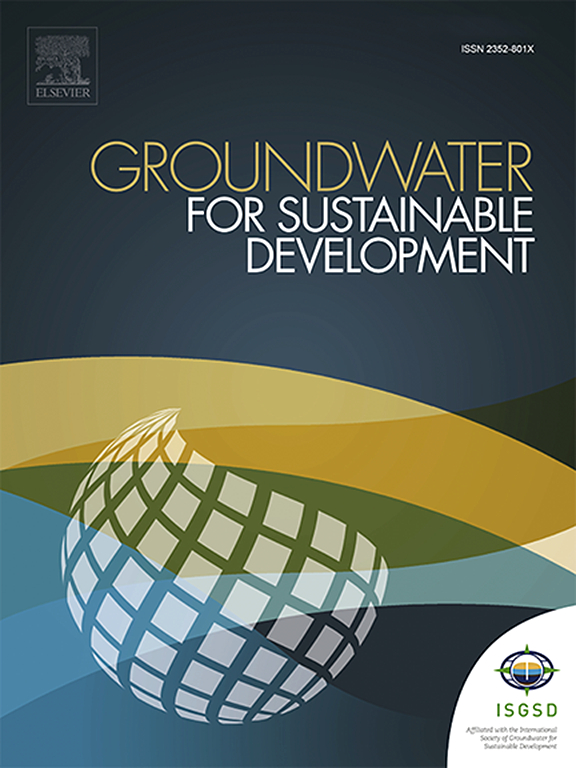加强微生物反应区的新思路:提高地下水中苯和萘的胶体性能
IF 4.9
Q2 ENGINEERING, ENVIRONMENTAL
引用次数: 0
摘要
煤化工场所释放的苯、萘等芳烃不受控制,对地下水水质构成严重威胁。原位微生物反应区(IMRZ)技术提供了一个很有前途的解决方案,但其有效性往往受到微生物分散性差和胶体不稳定性的限制。本研究提出了一种新的方法,通过将胶体二氧化硅掺入木氧化无色杆菌BP1的微生物接种物中来提高IMRZ的形成和性能。石英砂柱和水槽实验评估了微生物的迁移、聚集和生物降解效率。结果表明,胶体二氧化硅显著提高了微生物的稳定性和扩散,形成了明确的微生物反应区。胶体强化系统的苯和萘的降解效率在塔中分别达到57.47%和76.11%,在放大水槽系统中达到90%以上。全基因组分析和GC-MS代谢物分析显示,初级降解和协同代谢途径都有助于污染物的去除。这项研究展示了一种可扩展的、有效的方法来克服IMRZ技术的关键限制,推动了原位生物修复领域的发展。本文章由计算机程序翻译,如有差异,请以英文原文为准。

New ideas for enhancing the microbial reaction zone: Enhancing colloidal properties for the removal of benzene and naphthalene from groundwater
The uncontrolled release of aromatic hydrocarbons such as benzene and naphthalene from coal chemical sites poses significant threats to groundwater quality. In situ microbial reaction zone (IMRZ) technology offers a promising solution, but its effectiveness is often limited by poor microbial dispersion and colloid instability. This study presents a novel approach to enhancing IMRZ formation and performance by incorporating colloidal silica into the microbial inoculum of Achromobacter xylosoxidans BP1. Quartz sand column and flume experiments were conducted to assess microbial migration, aggregation, and biodegradation efficiency. Results showed that colloidal silica significantly improved microbial stability and diffusion, enabling the formation of clearly defined microbial reaction zones. The colloid-enhanced system achieved benzene and naphthalene degradation efficiencies of up to 57.47 % and 76.11 % in columns, and over 90 % in scaled-up flume systems. Whole-genome analysis and GC-MS metabolite profiling revealed that both primary degradation and co-metabolic pathways contributed to pollutant removal. This study demonstrates a scalable, efficient method to overcome key limitations in IMRZ technology, advancing the field of in situ bioremediation.
求助全文
通过发布文献求助,成功后即可免费获取论文全文。
去求助
来源期刊

Groundwater for Sustainable Development
Social Sciences-Geography, Planning and Development
CiteScore
11.50
自引率
10.20%
发文量
152
期刊介绍:
Groundwater for Sustainable Development is directed to different stakeholders and professionals, including government and non-governmental organizations, international funding agencies, universities, public water institutions, public health and other public/private sector professionals, and other relevant institutions. It is aimed at professionals, academics and students in the fields of disciplines such as: groundwater and its connection to surface hydrology and environment, soil sciences, engineering, ecology, microbiology, atmospheric sciences, analytical chemistry, hydro-engineering, water technology, environmental ethics, economics, public health, policy, as well as social sciences, legal disciplines, or any other area connected with water issues. The objectives of this journal are to facilitate: • The improvement of effective and sustainable management of water resources across the globe. • The improvement of human access to groundwater resources in adequate quantity and good quality. • The meeting of the increasing demand for drinking and irrigation water needed for food security to contribute to a social and economically sound human development. • The creation of a global inter- and multidisciplinary platform and forum to improve our understanding of groundwater resources and to advocate their effective and sustainable management and protection against contamination. • Interdisciplinary information exchange and to stimulate scientific research in the fields of groundwater related sciences and social and health sciences required to achieve the United Nations Millennium Development Goals for sustainable development.
 求助内容:
求助内容: 应助结果提醒方式:
应助结果提醒方式:


